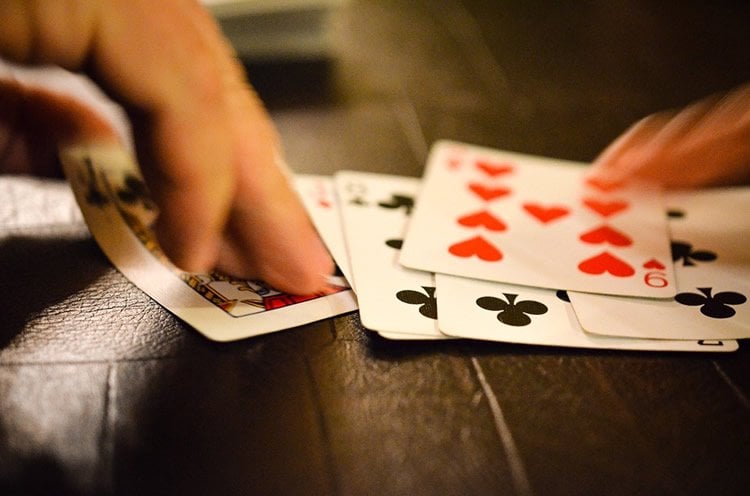Summary: Playing cards or throwing a soft ball may be as effective as virtual reality in helping people recover from strokes.
Source: St. Michael’s Hospital.
Sometimes in health care, simple activities CAN be just as effective as the latest technology.
A new study has found that simple, widely available and inexpensive activities such as playing cards or repeatedly throwing a foam ball or wad of paper into a wastepaper basket are just as effective in helping people regain strength and co-ordination following a stroke as playing virtual reality games.
The study, published today in the journal Lancet Neurology, is encouraging news for the 15 million people worldwide who suffer a stroke each year and may not live near a stroke rehabilitation centre or in a country with a sophisticated health-care system, or have health-care insurance, said lead author Dr. Gustavo Saposnik, a neurologist at St. Michael’s Hospital in Toronto.
The study was based on a clinical trial conducted at 14 centres in four countries in which patients were randomized into two groups. In addition to conventional rehabilitation therapy, one group received 10, one-hour sessions of virtual reality using the Nintendo Wii system and the other spent the same amount of time doing simple recreational activities such as playing cards or dominoes.
Patients randomized to both groups saw a 30 per cent and 40 per cent improvement in motor performance at the end of two weeks of the intervention and four weeks after the intervention, respectively.
“But there was no significant difference between the two groups in terms of strength, dexterity, gross motor skills, quality of life or activities of daily living,” said Dr. Saposnik, who is also a scientist in St. Michael’s Li Ka Shing Knowledge Institute. “We all like technology and have the tendency to think that new technology is better than old-fashioned strategies, but sometimes that’s not the case. In this study, we found that simple recreational activities that can be implemented anywhere may be as effective as technology.”

Dr. Saposnik said he was surprised by the results, because many previous studies, including his own, had a different conclusion, and because virtual reality has become an emerging strategy to enhance motor skills in stroke rehabilitation. Previous studies and review, including Dr. Saposnik’s pilot study published in 2010, suggested up to 20 to 30 per cent improvements in the motor skills of patients who had virtual reality therapy.
Dr. Saposnik said the new findings could be the result of the fact this clinical trial was the largest of its kind and used a more accurate comparison of the total time of therapy each group had. Both groups of randomized patients received the same amount of conventional therapy and then the same amount of time of either recreational activities or virtual reality. In previous studies, groups who received conventional and virtual reality therapy were compared to those who received only conventional therapy, with no add-ons.
Funding: This study received funding from the Heart and Stroke Foundation of Canada, the Ontario Stroke Strategy and the Ontario Ministry of Health and Long-Term Care.
Source: St. Michael’s Hospital
Image Source: This NeuroscienceNews.com image is in the public domain.
Original Research: Abstract for “Efficacy and safety of non-immersive virtual reality exercising in stroke rehabilitation (EVREST): a randomised, multicentre, single-blind, controlled trial” by Dr Gustavo Saposnik, MDcorrespondenceemail, Leonardo G Cohen, MD, Muhammad Mamdani, PharmD, Sepideth Pooyania, MD, Michelle Ploughman, PhD, Donna Cheung, OT, Jennifer Shaw, RhT, Judith Hall, MSc, Peter Nord, MD, Sean Dukelow, MD, Yongchai Nilanont, MD, Felipe De los Rios, MD, Lisandro Olmos, MD, Mindy Levin, PhD, Robert Teasell, MD, Ashley Cohen, MSc, Prof Kevin Thorpe, MMath, Prof Andreas Laupacis, MD, Mark Bayley, MD for Stroke Outcomes Research Canada in Lancet Neurology. Published online June 27 2016 doi:10.1016/S1474-4422(16)30121-1
[cbtabs][cbtab title=”MLA”]St. Michael’s Hospital. “Simple Recreational Activities Just As Effective As Virtual Reality For Stroke Rehab.” NeuroscienceNews. NeuroscienceNews, 28 June 2016.
<https://neurosciencenews.com/stroke-rehab-activities-4594/>.[/cbtab][cbtab title=”St. Michael’s Hospital”]St. Michael’s Hospital. (2016, June 28). Simple Recreational Activities Just As Effective As Virtual Reality For Stroke Rehab. NeuroscienceNews. Retrieved June 28, 2016 from https://neurosciencenews.com/stroke-rehab-activities-4594/[/cbtab][cbtab title=”Chicago”]St. Michael’s Hospital. “Simple Recreational Activities Just As Effective As Virtual Reality For Stroke Rehab.” https://neurosciencenews.com/stroke-rehab-activities-4594/ (accessed June 28, 2016).[/cbtab][/cbtabs]
Abstract
Efficacy and safety of non-immersive virtual reality exercising in stroke rehabilitation (EVREST): a randomised, multicentre, single-blind, controlled trial
Background
Non-immersive virtual reality is an emerging strategy to enhance motor performance for stroke rehabilitation. There has been rapid adoption of non-immersive virtual reality as a rehabilitation strategy despite the limited evidence about its safety and effectiveness. Our aim was to compare the safety and efficacy of virtual reality with recreational therapy on motor recovery in patients after an acute ischaemic stroke.
Methods
In this randomised, controlled, single-blind, parallel-group trial we enrolled adults (aged 18–85 years) who had a first-ever ischaemic stroke and a motor deficit of the upper extremity score of 3 or more (measured with the Chedoke-McMaster scale) within 3 months of randomisation from 14 in-patient stroke rehabilitation units from four countries (Canada [11], Argentina [1], Peru [1], and Thailand [1]). Participants were randomly allocated (1:1) by a computer-generated assignment at enrolment to receive a programme of structured, task-oriented, upper extremity sessions (ten sessions, 60 min each) of either non-immersive virtual reality using the Nintendo Wii gaming system (VRWii) or simple recreational activities (playing cards, bingo, Jenga, or ball game) as add-on therapies to conventional rehabilitation over a 2 week period. All investigators assessing outcomes were masked to treatment assignment. The primary outcome was upper extremity motor performance measured by total time to complete the Wolf Motor Function Test (WMFT) at the end of the 2 week intervention period, analysed in the intention-to-treat population. This trial is registered with ClinicalTrials.gov, number NTC01406912.
Findings
The study was done between May 12, 2012, and Oct 1, 2015. We randomly assigned 141 patients: 71 received VRWii therapy and 70 received recreational activity. 121 (86%) patients (59 in the VRWii group and 62 in the recreational activity group) completed the final assessment and were included in the primary analysis. Each group improved WMFT performance time relative to baseline (decrease in median time from 43·7 s [IQR 26·1–68·0] to 29·7 s [21·4–45·2], 32·0% reduction for VRWii vs 38·0 s [IQR 28·0–64·1] to 27·1 s [21·2–45·5], 28·7% reduction for recreational activity). Mean time of conventional rehabilitation during the trial was similar between groups (VRWii, 373 min [SD 322] vs recreational activity, 397 min [345]; p=0·70) as was the total duration of study intervention (VRWii, 528 min [SD 155] vs recreational activity, 541 min [142]; p=0·60). Multivariable analysis adjusted for baseline WMFT score, age, sex, baseline Chedoke-McMaster, and stroke severity revealed no significant difference between groups in the primary outcome (adjusted mean estimate of difference in WMFT: 4·1 s, 95% CI −14·4 to 22·6). There were three serious adverse events during the trial, all deemed to be unrelated to the interventions (seizure after discharge and intracerebral haemorrhage in the recreational activity group and heart attack in the VRWii group). Overall incidences of adverse events and serious adverse events were similar between treatment groups.
Interpretation
In patients who had a stroke within the 3 months before enrolment and had mild-to-moderate upper extremity motor impairment, non-immersive virtual reality as an add-on therapy to conventional rehabilitation was not superior to a recreational activity intervention in improving motor function, as measured by WMFT. Our study suggests that the type of task used in motor rehabilitation post-stroke might be less relevant, as long as it is intensive enough and task-specific. Simple, low-cost, and widely available recreational activities might be as effective as innovative non-immersive virtual reality technologies.
Funding
Heart and Stroke Foundation of Canada and Ontario Ministry of Health.
“Efficacy and safety of non-immersive virtual reality exercising in stroke rehabilitation (EVREST): a randomised, multicentre, single-blind, controlled trial” by Dr Gustavo Saposnik, MDcorrespondenceemail, Leonardo G Cohen, MD, Muhammad Mamdani, PharmD, Sepideth Pooyania, MD, Michelle Ploughman, PhD, Donna Cheung, OT, Jennifer Shaw, RhT, Judith Hall, MSc, Peter Nord, MD, Sean Dukelow, MD, Yongchai Nilanont, MD, Felipe De los Rios, MD, Lisandro Olmos, MD, Mindy Levin, PhD, Robert Teasell, MD, Ashley Cohen, MSc, Prof Kevin Thorpe, MMath, Prof Andreas Laupacis, MD, Mark Bayley, MD for Stroke Outcomes Research Canada in Lancet Neurology. Published online June 27 2016 doi:10.1016/S1474-4422(16)30121-1






